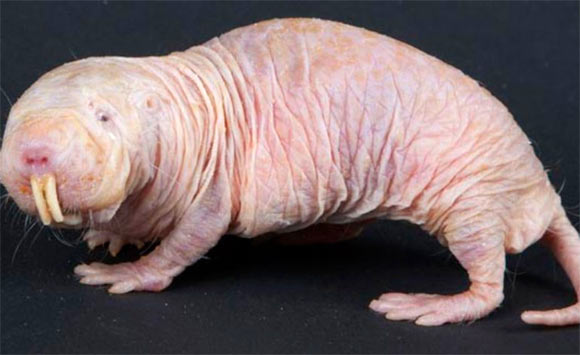Naked mole-rats (Heterocephalus glaber) form some of the most cooperative groups in the animal kingdom, living in multigenerational colonies under the control of a single breeding queen. Little is known about how individuals within these colonies navigate the many interactions that must occur in such a complex cooperative group. A new study shows that calls emitted by individuals, in particular the common ‘chirp’ call, convey information about group membership, creating distinctive colony dialects; what’s more, these dialects are culturally transmitted across generations, supporting the idea that social complexity evolved concurrently with vocal complexity.
Naked mole-rats are nearly hairless and nearly sightless burrowing rodents found throughout most of Somalia, central Ethiopia, Djibouti, and much of northern and eastern Kenya.
They live in large colonies, which vary in number from 75 to 300 individuals, deep underground in hypoxic conditions.
The colonies are extended family groups, with overlapping generations. Reproduction is restricted to a single reproductive female, and at most three breeding males.
Adults are 3-4 inches (7-10 cm) long and weigh 30-35 grams. The queen and the breeding males are the largest individuals in the colony.
Naked mole-rats hold the record for the longest living rodent, living nearly 9 times longer than other species. They have been known to reach ages of 30 years. In captivity, they can live up to 28 years.
They feed on geophytic plants such as roots, bulbs, and tubers which are accessible underground. The foods they prefer are sporadically spread out so they travel great distances to get food.
Naked mole-rats are also highly xenophobic and are known to attack and kill those from other colonies. However, how these mostly blind creatures maintain their complex and highly organized social structure is mostly a mystery.
“Foreigners are not welcome in an established naked mole rat colony. You might even say that these animals are extreme xenophobes,” said co-senior author Professor Gary Lewin, a researcher in the Department of Neuroscience at the Max Delbrück Center for Molecular Medicine.
“This behavior is probably a result of the permanent shortage of food in the dry plains of the naked mole rat’s East African habitat.”
“Within their own colony, however, the rodents work together harmoniously. Each one knows its rank and the tasks it has to perform and usually accomplishes them reliably.”
To investigate the role of vocal communication in mole-rat society, Professor Lewin and his colleagues recorded a total of 36,190 chirps made by 166 individuals from seven naked mole-rat colonies held in labs in Germany and South Africa.
They then applied machine learning techniques to analyze the acoustic properties of these vocalizations.
“We wanted to find out whether these vocalizations have a social function for the animals, who live together in an ordered colony with a strict division of labor,” he said.
The researchers found that naked mole-rats have distinctive soft chirps, unique to an animal’s group, and that this dialect is determined by a colony’s queen and is learned by mole-rat pups early in life.
However, these dialects are not fixed; they change when a colony’s queen dies and is replaced, and young pups fostered in foreign colonies learn the dialect of their adoptive groups.
This suggests that individual colony dialects, including their transmission from generation to generation, is cultural rather than genetic.
“We established that each colony has its own dialect,” said first author Dr. Alison Barker, also from the Department of Neuroscience at the Max Delbrück Center for Molecular Medicine.
“The development of a shared dialect strengthens cohesion and a sense of belonging among the naked mole-rats of a specific colony.”
“Human beings and naked mole-rats seem to have much more in common that anyone might have previously thought,” Professor Lewin said.
“Naked mole-rats have a linguistic culture that developed long before human beings even existed.”
“The next step is to find out what mechanisms in the animals’ brains support this culture, because that could give us important insight into how human culture evolved.”
A paper on the findings was published in the journal Science.
_____
Alison J. Barker et al. 2021. Cultural transmission of vocal dialect in the naked mole-rat. Science 371 (6528): 503-507; doi: 10.1126/science.abc6588








